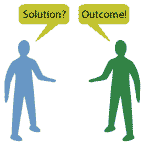How Would You Define A Customer Outcome?
Executives at large accounts with complex problems want more than your “solution” – and rarely have a line item in their budget for your offering. Instead, they have an initiative, with a goal, an objective…and a desired outcome. And they lament that salespeople are often unprepared to have a discussion about the buyer’s issues and where they can help.
 A customer’s desire for a business outcome is an important force that’s separating strategic vendors from commodity suppliers. We think that this idea of an outcome — in fact, an emerging Outcome Economy —needs to be clearly understood as being different from simply providing solutions and benefits. So what is the difference? Are you selling outcomes for your key customers? How would you know? And how can you help account teams have conversations about them?
A customer’s desire for a business outcome is an important force that’s separating strategic vendors from commodity suppliers. We think that this idea of an outcome — in fact, an emerging Outcome Economy —needs to be clearly understood as being different from simply providing solutions and benefits. So what is the difference? Are you selling outcomes for your key customers? How would you know? And how can you help account teams have conversations about them?
Here are our initial thoughts on what qualifies, in the customer’s eyes, as an outcome:
- An achieved end state. An outcome is grounded in reality, and includes all of the things that the customer does in that future state. It’s more than the ‘desired’ end state, which can sometimes be unrealistic at worst, aspirational at best. Describing an outcome includes addressing the practical realities that the customer will face to achieve its business goals.
- Verified through measurable results. Those results might not always be financial, but still testable and observable so that there’s little doubt about whether they have been achieved.
- Tied to a funded “top-level” initiative. An outcome is tied to an initiative that is chartered and funded, and isn’t subordinate to, or rolled under, a broader plan. It’s important to get the ‘altitude level’ right. A goal like “giving our field support team handheld devices and applications” is a means to some greater end, like “Near-zero customer downtime.” Benefits should be traceable up the chain from projects like installing a faster wireless network – through business metrics like departmental productivity – all the way to fiscal goals and ultimately corporate earnings.
- Defined through the lens of a particular executive responsible for the end state. An initiative’s results and challenges and their relative importance will vary depending on the perspective of different people within the organization. The perspective of the accountable individual — the one who’s job is at risk if the initiative fails — matters most.
- Colored by the interests of related stakeholders. Achieving outcomes takes coordination and support across functional areas with a company.
- Reached over time though a problem-solving lifecycle. The path to achieving the end state is bigger than selecting, procuring, and deploying a vendor’s product. The arc can begin as early as defining the right core problem and extend well beyond ensuring user adoption.
We see “outcomes” as an important way to frame conversations with clients and meet them on their terms and Forrester plans to explore this more deeply.